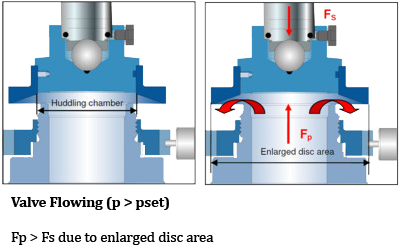内容(点击链接导航)
安全阀 主要有两种类型 :弹簧-- 装载 式安全阀 和先导--操作式安全阀 。同样相关的还有所谓的切换阀 ,它能确保系统的持续可用性。
弹簧 加载 式安全阀 是安全阀 的主要类型 之一,其中的闭合力或弹簧力由螺旋弹簧 施加。
阀门关闭
在直接弹簧 加载的安全阀 中,关闭力或弹簧 力由螺旋弹簧 施加,而螺旋弹簧 则由调整螺栓 压缩。弹簧力 通过销钉传递到阀瓣 上。只要弹簧 力大于阀门入口处 压力产生的力,阀瓣 密封就 会顶住喷嘴。图中显示了放大的安全阀 喷嘴 和阀瓣 区域,以及作用在阀瓣 上的力。
阀瓣下方的压力 必须高于设定压力 ,安全阀 才能达到明显的升程。由于阀瓣 和调整环 之间的流动受到限制,挤压室中会产生压力。压力现在作用于扩大的阀瓣 区域。这增加了力 Fp,从而克服了进一步压缩弹簧 所需的额外力。在大多数情况下,阀门会 "啪 "的一声迅速打开,达到最大升程。
超压 是指 安全阀 达到全升程和排放量 所需的高于设定压力 的压力 增幅 。超压 通常以设定压力 的百分比表示。规范和标准规定了最大超压 的限定值 。典型值为 10%,视规范和应用而定, 介于 3% 和 21% 之间。

阀门关闭
在大多数应用中,当阀瓣充气 时,尺寸合适的安全阀会降低容器中的压力。容器内的压力将在随后的任何时间点下降,但不会晚于溢流情况结束的时间。容器内压力的降低将减小力 Fp。然而,在设定压力 时,流量仍作用于增大的阀瓣区 ,这将使阀门保持打开。需要进一步降低压力,直到弹簧 力 Fs 再次大于 Fp, 安全阀 开始重新关闭。在重新达到基座压力时,阀瓣将再次接触喷嘴 ,安全阀 重新闭合。
排放是指安全阀 的设定压力 与再 设定压力 之间的差值,以设定压力的 百分比表示。规范和标准中定义的典型排放 值为 -7% 和 -10%,根据规范和服务(蒸汽、气体或液体)的不同,范围从 -4% 到 -20%。
什么是弹簧加载式 安全阀 ?
弹簧加载 式安全阀 是安全阀 的主要类型 之一,其关闭力或弹簧 力由螺旋弹簧 施加。
弹簧加载式 安全阀是如何工作的?
安全阀的设计 是打开并释放容器或设备中的多余压力,然后再次关闭。弹簧式 安全阀 是安全阀 的主要类型 之一,其关闭力或弹簧 力由螺旋弹簧施加。